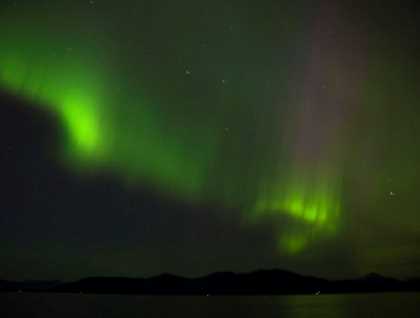Today has been another amazing day with sunny skies, lots of wildlife, and plenty of adventure. We started the day enjoying time on the bow while our captain safely maneuvered National Geographic Sea Bird through Wrangell Narrows passage. We were accompanied by bald eagles diving for fish, surf scoters, pigeon guillemots, Bonaparte’s gulls, arctic terns, a yellow-billed loon, harlequin ducks, white-winged scoters, common murres, and even a foraging black bear.
After we arrived in Petersburg, an iconic Alaska town fashioned with a fleet of fishing boats, we divided into groups to explore the area. Some went on photo walks capturing the beauty of the neighboring docks, while others went for a hike to a muskeg to see the bizarre flora. We passed under a raven’s nest full of chicks, and watched a bald eagle perched in its nest as well. Experiencing a musket, or bog, is an important element of the Alaska experience. More than 10% of “Southeast” is covered by this diverse habitat, yet this ecosystem is, in one word, weird. The ground is completely saturated with acidic water, which prevents most organic materials from decomposing. The result is a soil void of nutrients, leaving most of the plants dwarfed with malnutrition. Don’t be sad though, as this opens up room for a rich biodiversity. Many flowering plants are able to colonize the area, alongside insects and different birds. The most peculiar of this nutrient-poor region are the formidable, flesh-eating sundews. These plants are the worst nightmare for flying insects like mosquitos and beetles, which become trapped in the sundew’s sticky tentacles. They are duped by the flower’s rosy red flesh, until they are ensnared and filled with regret. Once they die and decompose, their death becomes the sundew’s new life, and the ancient elements are transferred from insect to plant.
Before setting sail, everyone got a chance to explore downtown and stock up on souvenirs. With hands full of shopping bags and lighter wallets, we returned to the ship in time for our famous crab feast. We ate enough crab to satiate a romp of otters, trying our hardest to emulate their behavior of eating 25% of their bodyweight daily.
With plates empty and bellies full, we moved to the bow to enjoy the alpenglow illuminating glaciers and the famous Devil’s thumb. We found a humpback whale and watched him surface and dive while the clouds overhead turned amber and pink. A crab feast and a sunset humpback—yep, this is the good life.
But wait, there’s more! Just as you finish reading this expedition report, and just as I thought I was finished writing it (at midnight), word came over the radio, “We’ve got northern lights.” Indeed we did, and by the time I made it to the bow, already the recognizable green curtains were taking shape. I ran back downstairs, woke up the other photo instructors, sent word for our expedition leader, and we announced into every guest’s cabin, “wake up sleepy-heads, we’ve got northern lights.” What ensued was three hours of sheer awe, filled with intermittent laughter at the incredible spectacle overhead. Yes, we are lucky, and this trip has been more than any of us could have anticipated. We’ve had a spirit bear, we’ve been surrounded by 100-150 humpbacks, and now we are witness to one of the most impressive Northern Lights displays anyone aboard has ever seen. This has been undoubtedly a remarkable journey.







